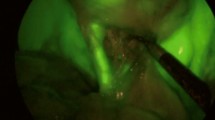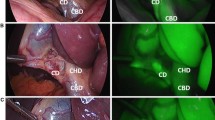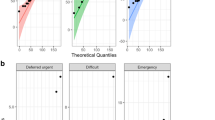Abstract
Background
Bile duct injury is a rare but serious complication of minimally invasive cholecystectomy. Traditionally, intraoperative cholangiogram has been used in difficult cases to help delineate anatomical structures, however, new imaging modalities are currently available to aid in the identification of extrahepatic biliary anatomy, including near-infrared fluorescent cholangiography (NIFC) using indocyanine green (ICG).1,2,3,4,5 The objective of the study was to evaluate if this technique may aid in safe dissection to obtain the critical view.
Methods
Thirty-five consecutive multiport robotic cholecystectomies using NIFC with ICG were performed using the da Vinci Firefly Fluorescence Imaging System. All patients received 2.5 mg ICG intravenously at the time of intubation, followed by patient positioning, draping, and establishment of pneumoperitoneum. No structures were divided until the critical view of safety was achieved. Real-time toggling between NIFC and bright-light illumination was utilized throughout the case to define the extrahepatic biliary anatomy.
Results
ICG was successfully administered to all patients without complication, and in all cases the extrahepatic biliary anatomy was able to be identified in real-time 3D. All procedures were completed without biliary injury, conversion to an open procedure, or need for traditional cholangiography to obtain the critical view. Specific examples of cases where x-ray cholangiography or conversion to open was avoided and NIFC aided in safe dissection leading to the critical view are demonstrated, including (1) evaluation for aberrant biliary anatomy, (2) confirmation of non-biliary structures, and (3) use in cases where the infundibulum is fused to the common bile duct.
Conclusion
NIFC using ICG is demonstrated as a useful technique to rapidly identify and aid in the visualization of extrahepatic biliary anatomy. Techniques that selectively utilize this technology specifically in difficult cases where the anatomy is unclear are demonstrated in order to obtain the critical view of safety.
Similar content being viewed by others
References
Alander JT, Kaartinen I, Laakso A, et al. A review of indocyanine green fluorescent imaging in surgery. Int J Biomed Imaging. 2012;2012:940585.
Boni L, David G, Mangano A, et al. Clinical applications of indocyanine green (ICG) enhanced fluorescence in laparoscopic surgery. Surg Endosc. 2015;29(7):2046–2055.
Liu YY, Kong SH, Diana M, et al. (2015) Near-infrared cholecysto-cholangiography with indocyanine green may secure cholecystectomy in difficult clinical situations: proof of the concept in a porcine model. Surg Endosc. 30:4115-23
Pesce A, Piccolo G, La Greca G, Puleo S. Utility of fluorescent cholangiography during laparoscopic cholecystectomy: a systematic review. World J Gastroenterol. 2015;21(25):7877–7883.
Giulianotti PC, Bianco FM, Daskalaki D, et al. (2016) Robotic Liver Sugery: technical aspects and review of the literature, Hepatobiliary Surgery and Nutrition. 5(4):311–321
Author information
Authors and Affiliations
Contributions
- Conception or acquisition and interpretation of data—AVM, NK.
- Drafting the work or revising it critically and final approval—AVM, NK.
- Agreement to be accountable for all aspects of the work in ensuring that questions related to the accuracy or integrity of any part of the work are appropriately investigated and resolved—AVM, NK.
Corresponding author
Ethics declarations
Conflict of Interest
The authors declare that they have no conflict of interest.
Electronic supplementary material
(WMV 291753 kb)
Rights and permissions
About this article
Cite this article
Maker, A.V., Kunda, N. A Technique to Define Extrahepatic Biliary Anatomy Using Robotic Near-Infrared Fluorescent Cholangiography. J Gastrointest Surg 21, 1961–1962 (2017). https://doi.org/10.1007/s11605-017-3455-5
Received:
Accepted:
Published:
Issue Date:
DOI: https://doi.org/10.1007/s11605-017-3455-5




